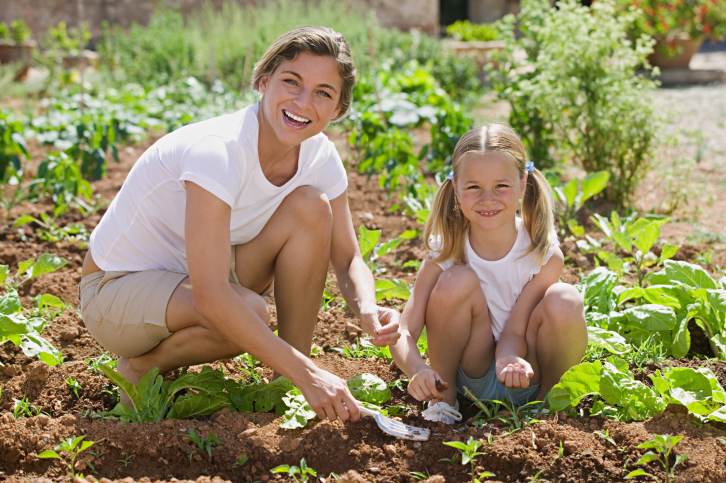Spring has sprung, and it’s a great time to begin gardening! Gardening helps you get outside in the sunshine and fresh air, and it can even help you be more physically active. Plus, planting edible plants can yield money saved and fresh, nutritious produce that you and your family will enjoy eating. But before you start digging, here are a few things to consider:
Garden size
To yield the most produce, gardens need to be well-tended. That means they need to be watered, weeded, and harvested on a regular basis. How much time do you have to commit to these tasks? Smaller gardens generally require less time than bigger gardens. Before you start creating your garden, realistically consider the amount of time you are able to give to your garden. Let your time commitment help you choose what size garden to create.
It’s also important to think about the type of plants you want to grow, how many of each, and how much space they need. Most plants or seeds have this information on their packaging, or you can ask an expert at your local garden center. If you don’t have much space, consider window boxes or large planter bowls which can be grown on patios, balconies, or even inside.
Where to plant
Ideally, your garden plot should have at least partial sunlight to ensure your plants stay healthy (full sunlight is most ideal)! Easy access to water is also a must. Adequate soil that drains well and isn’t too sandy will provide the best foundation for your plants.
Get digging!
Before you plant anything, prepare the area for your garden by removing any grass and debris. Turn the soil either by digging with a shovel or using a tiller, and add compost to provide a rich growing environment for your plants. Mix the compost with the soil as you dig. If your soil has a lot of clay or sand, you may need to add soil that you can buy from your local garden center. When you’re finished, water the soil and let it rest for a couple of days. While you’re waiting, buy your plants!
Choose your plants
First, think about what you and your family enjoy eating. Visit your local garden center and pick seed packets for foods, like vegetables and herbs, that your family likes. Be sure to read the packaging carefully to understand what each plan requires. For example, if you want to plant a certain veggie that needs a lot of full sunlight, and you don’t feel like you can provide that, it’s best to choose another vegetable that has a better chance of flourishing in your environment.
You can learn more about how many plants you should plant by understanding how often they produce crops. For instance, vegetables like peppers and tomatoes yield fruit throughout the growing season, whereas corn only produces one time. The more frequent the yield, the fewer plants you will need.
It’s also important to consider where you’re planting them—will they be in a backyard garden, a window box, or a planter box? For example, only certain types of plants, like herbs and lettuces, will flourish in planter boxes and bowls, so you are somewhat limited if you are using these containers instead of planting a full garden.
Also, many plants are seasonal and grow best at certain times of the year and in certain climates. Click here to find a vegetable planting guide specific to your area.
Ready, set, plant!
Decide where you want each type of plant to grow and plan out the garden plot, paying careful attention to the space needed for each plant. You may also want to consider including “ally plants” which are planted next to your crop plants and act as natural pest repellents. Common allies include chives, marigolds, and garlic.
Remove each plant from its container and dig a hole to fit the size of the plant. Place the roots of the plant in the hole after loosening them, then cover with soil. Water the garden well, and you’re done! Be sure to tend to your garden by regularly watering the plants as needed and removing weeds.
If you’re a Health Advocate member with access to the Wellness Coaching program, reach out to your Wellness Coach for more healthy tips.




[…] are a few tips to help you get started with your garden this season, and don’t forget safety first! The CDC offers some advice to […]